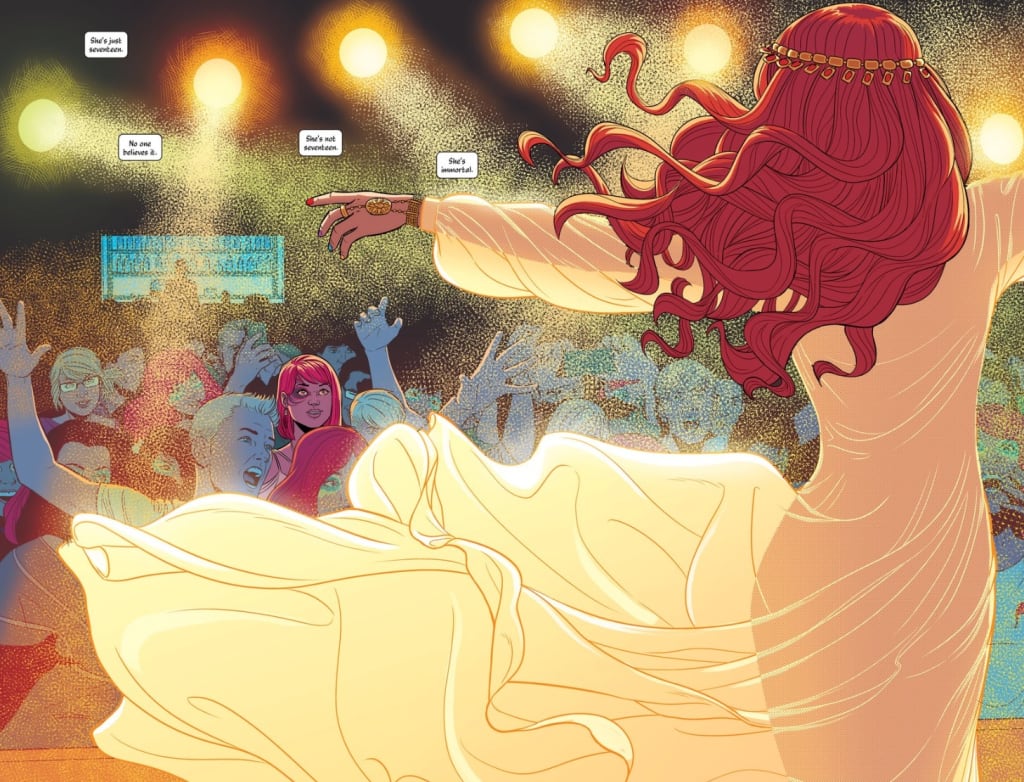'The Wicked + the Divine:' The Faust Act
Magic, Mayhem, Pop Music

Kieron Gillen and Jamie McKelvie's seminal comics series, The Wicked +the Divine, plunges the reader into a world where every ninety years twelve Gods incarnate on Earth and have two years to do whatever they want before returning to the realms they came from. In the past, they've been poets, muses, artists, and the like; in the modern age, they are pop musicians and icons.
The book follows Laura, a pantheon super fan, as she attends one of Amaterasu's gigs and falls in love, borne away on the God's music until she blacks out. Upon waking she meets Lucifer, styled as a female version of David Bowie's Thin White Duke, who takes her under her wing and lets her sneak into an interview between Amaterasu and a journalist, Cassandra. A pair of gunmen disrupts the interview when they try to assassinate the Gods and Lucifer steps in, detonating their heads with a click of her fingers. When the Judge at her trial suffers the same fate, the plot really begins.
Laura acts as the reader, everything we see is drawn from her experience, from fan to confidante and then, unwilling, accessory. She's a typical teenager, obsessed with music, sex, and celebrity and longing for something to call hers. It's an idea that really works, given the nature of what's going on; if she were older the fascination with the pantheon would seem strange instead of typical and the character wouldn't ring true.
The story follows her, as she gets more involved in the world of the pantheon, trying to clear Lucifer's name and find the Judge's real killer. The reader is introduced to the other members of the pantheon. Gillen guides us through the different personalities, from the Tron-like Wodan and his creepy army of Asian valkyries; the childlike Minerva with her mechanical owl; to Morrigan and Baphomet who dwell underground, holding impromptu gigs on London Underground station platforms. Alone of the pantheon, they seem to revel in their power, using it impress their followers and underline the fact they are gods even if they only have two years to enjoy it.
This arc contains the first five issues and the story details Lucifer's rise and inevitable fall, setting up the series and asking questions that only get answered as it continues. As a result, while this is a great story that could stand alone perfectly, the intent is obviously to get the reader to want more and be intrigued enough by what's going on to keep coming back.
The writing is clear, the characterisation fascinating. Lucifer is mercurial, rebellious, and confident; Amaterasu, kind and gentle; Baal, strong, confident, and proud. None of them feels human, in the way that Laura and Cassandra do, and it feels as if the creators made a conscious decision to hold them at arm's length to the reader, only letting us see enough to be fascinated by them. Visually, the creators have made some really interesting design choices with the book, consciously modeling the pantheon on pop culture references. Amaterasu, for example, obviously draws on both Florence from Florence and the Machine and on Kate Bush. In a similar fashion, Minerva's owl draws the influence for its design from Bubo in Clash of the Titans. In this way, Gillen and McKelvie instill designs and artistic influences into a world where it feels oddly right to see them all together.
About the Creator
Steve Cotterill
Hi,
I'm a writer, nerd and roleplayer (the tabletop kind). I love comics, horror, Goth music, and kink.






Comments
There are no comments for this story
Be the first to respond and start the conversation.